
Ship's Surgeons as Barbers Page Menu: 1 2 3 4 5 6 7 Next>>
The Ship's Surgeon as BARBER-Surgeon, Page 5
Barbering Instruments: The Shaving Bowl
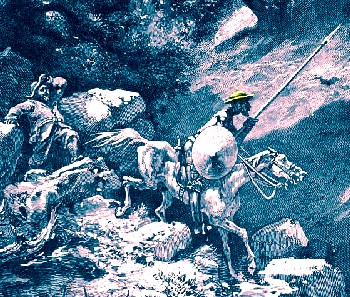
Artist: Gustav Doré
Don Quixote Wearing the Shaving Bowl of Mambrino (1863)
"'How can I be mistaken, scrupulous traitor? replied Don Quixote: seest thou not yonder knight who rides this way, upon a dapple steed, with a golden helmet on his head?'
'What I perceive and discern, said Sancho, is no other than a man upon a grey ass, like my own, with something that glitters on his head.'
'And that is the very helmet of Mambrino, replied the knight'...
The whole affair of the helmet, steed, and knight, which Don Quixote saw, was no more than this: in that neighbourhood, were two villages, one of them so poor and small, that had neither shop nor barber: for which reason, the trimmer of the larger that was hard by, served the lesser also, in which, at that time was a sick person to be blooded, and another to be shaved; so that this barber was going thither with his brass bason under his arm: but, as it chanced to rain when he was on the road, that he might not spoil his hat, which probably was a new one, he sheltered his head under the bason, which being clean scoured, made a flaming appearance. at the distance of half a league; and, as Sancho had observed, he rode upon a grey ass, which gave occasion to Don Quixote to believe he was some knight with a helmet of gold, mounted upon a dapple steed; for, he accomodated ever thing he saw with incredible facility, to the extravagent ravings of his disordered judgment." (Miguel Cervantes and Tobias Smollett, The History and Adventures of the Renowned Don Quixote, Volume 1, p. 125-6)

Client Holding a Barber's
Basin
from Encyclopedie
des
Sciences et Metiers
by
Denis Diderot (1769)
Every barber from this period would have had a shaving bowl, so long as there were no delusional 17th century Spaniards claiming this humble instrument was actually a golden Moorish king's helmet and taking it from them.
Little is actually said in period books about the shaving bowl (also called a barber's dish or basin). It functioned as a sort of portable sink that held soap and water for the barber. It would also catch the detritus of the razor as the barber shaved the customer. Some barber's bowls had a little indentation in them where hard soap would be placed 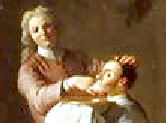
Artist: Michel Ange Houasse
Client Holding Brass Barbering
Bowl from The Barber Shop (1719)
for the convenience of the barber.1
The rounded, sort of half-moon indent in the lip of the bowl was designed to accommodate the neck of the person being shaved. The customers would hold the barbering bowl in place while the barber shaved.
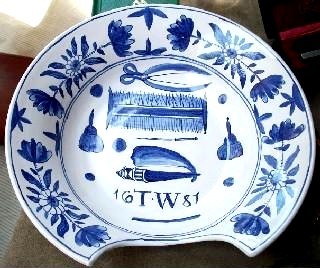
Photo: Rosabella
The Author's First Delftware-Style Reproduction Barbering Bowl
(Sadly, it was broken during transport to an event.)
Shaving bowls were typically about the size of a dinner plate, having a depth of 1 - 2 inches. They were made from a wide variety of materials including metals, wood, brass, pewter and many varieties of clays and ceramics.2
According to E. Alfred Jones, one of the earliest barbering bowls was that of Louis I, Duke of Anjou. It was made of silver and dates to the late 14th century.3
During the golden age of piracy, Delftware barbering bowls (pottery bowls made in Delft, Netherlands and decorated with blue images) seem to have been popular (such as the one pictured at right). These often featured images of barber's tools, barbers at work and similar fanciful designs. An internet image search for Delftware barber bowl produces
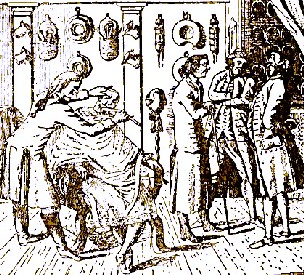
An 18th Century Barbershop. Note the Barber's Bowls
and
Other Equipment on the Wall. From Master
Johann
Dietz,
Surgeon in the Army of the Great Elector and
Barber to
the Royal Court, p. 258
some lovely examples of such art. In addition, Jones tells us that "Oriental porcelain dishes [were] made for the European market in the eighteenth century"4.
Of course, bowls were made of many materials at this time. Modern naval surgeon John Kirkup explains that the manufacturing of pewter "achieved particular importance from the sixteenth to the nineteenth centuries, principally for such things as domestic utensils, plates, bowls, chamber pots, and urinals and medically for barbers' shaving and bleeding bowls, irrigating and enema syringes, leech containers, speculums, bougies, sounds and many items of hospital equipment."5
The barber's bowl sometimes had a hook or loop attached to it (if it were metal) or two holes in it (if ceramic) which the barber used to hang it on the wall when not in use.
They could also apparently be used as serving dishes if the need arose, "a statement confirmed by the sale at Donai in 1775, when among the things advertised was 'a shaving dish of beautiful shaped work which can be used as a dessert dish.'"6 One hopes that particular bowl wasn't emblazoned with images of razors and combs.

Surgions Mate author John Woodall
The shaving bowl, while a necessary part of the barber's job, didn't seem to rate highly as far as equipment goes. Sea surgeon John Woodall dismisses it by saying, "I have nothing to write concerning it, but that at the least the Surgeons Mate have one if not two, and if he finde no use for it let him sell it for good liquor at Bantham, as a Surgeons Mate lately did one of mine."7 (One gets the impression Woodall mentioned this tool in his book specifically to air that particular gripe. Although it might have been interesting to hear what Woodall did to the surgeon's mate after he learned the fate of his barbering bowl.)
Occasionally you come across the idea that the barbering bowls were also used to collect blood when the barber performed bloodletting. For example, Woodall notes that "the German Surgeons doe ever let blood into a [barber's] Bason"8.
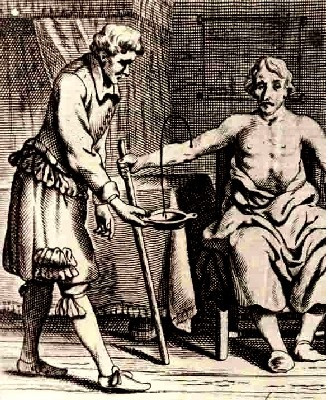
Bloodletting, Johannes Scultetus (1693)
However, Woodall goes on to explain that this is a bad idea, particularly for newly trained surgeon's mates, because it doesn't allow them to accurately measure how much blood is being let. Instead he suggests that "the blood porringers which are made for that purpose being full, hold just three ounces, and somewhat more: for my owne practice I hold this course; if one chance to come to me of himselfe, or by advise of a Phisition to be let bloud, though he be a strong body I never take from him more then two porringers and one halfe at the most, but often lesse, if the party be not strong"9.
In her book on the history of surgical equipment, Elizabeth Bennion makes another interesting point against barbering bowls being used for bloodletting. She notes that the 1700 era Delftware is "decorated in blue and white, with pieces of barbers equipment – combs, scissors, razors, and so on – but no surgical instruments"10. While absence of something is not proof against it, it is still an interesting point.
1 Rory W. McCreadie, The Barber Surgeon's Mate of the 16th and 17th Century, p. 41; 2 E. Alfred Jones, "Silver Shaving Dishes", Museum of Fine Arts Bulletin, Vol. 14, No. 81, Feb 16, 1916, p. 7; 3 Jones, ibid, 4 Jones, p. 8; 5 John Kirkup, The Evolution of Surgical Instruments; An Illustrated History from Ancient Time to the Twentieth Century, p. 100-1; 6 Jones, p. 8; 7 John Woodall, the surgions mate, p. 34; 8,9 Woodall, p. 35; 1 Elizabeth Bennion, Antique Medical Instruments, p. 184-5
Barbering Instruments: Soap
"Meanwhile the manservant was holding before him [an officer in the German army in the late 17th century], where he sat reclining in large chair, a great silver basin full of soapsuds." (Joannes Dietz, Master Johann Dietz, Surgeon in the Army of the Great Elector and Barber to the Royal Court, Translated by Bernard Miall, p. 92)
The idea of using a shaving soap today brings to mind a smooth, foamy mixture, usually spat out from a can. This was not what would have been used during the golden age of piracy, however. The type of soap used to prepare the face for shaving during this time was the same as was used for other purposes. Even the hard soaps specifically designed to be whipped into a lather using a shaving brush had not been invented.
Rory McCredie explains the way such soap was produced.
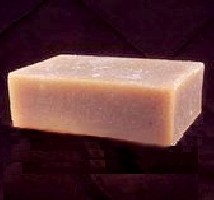
Golden Age of Piracy Style Soap
It was made by pouring water into a large tub with holes in the bottom. In the but were a layer of twigs over which was put a cloth (muslin). Then the tub was filled with ash, which would leach out the alkaline salts and make 'lye'. The 'lye' was reduced until an egg would float on it, animal fat was added and it was boiled for hours... Salt was added together with a 'bouquet garni' of herbs. When the salt had settled, the soap was put into moulds (blocks, sea shells, etc.), or tied in to balls with a pudding bag cloths and left for 3-4 weeks to harden.1
The pieces of hard soap would then be used to create a lather in the barbering bowl. Barber Jean-Jaques Perret explains the procedure used to do this. The person shaving "must make use of hot water, or at least as tepid as you can stand it... Because the face is so sensitive when dry, and is much less so when it is washed, the more it is wetted, the less you will feel sensations of pain"2. He then suggests rolling the hard soap in the water to create a foam. "A light & lively hand foams soap in the water"3. Perret noted that too much soap was not helpful when shaving. "I've seen people that rub so hard that the soap forms gum on their face, which is absolutely worthless; three or four strokes of soap, lightly applied, are much better to prepare the beard."4 His theory was the the soap "cleaned the pores and dilated the hair, the oil penetrating to its spirit below softens it, and prepares it to receive the razor's edge"5.
1 Rory W. McCreadie, The Barber Surgeon's Mate of the 16th and 17th Century, p. 41; 2 Jean-Jacques Perret, La Pogonotomie, interpreted by Mark Kehoe, p. 59; 3 Perret, p. 60; 4 Perret, p. 59-60; 5 Perret, p. 60
Barbering Instruments: Shaving Brush
You may have noticed that shaving brushes weren't mentioned in the period descriptions of soap. This is because they are generally believed not to have been use during the golden age of piracy. The first shaving
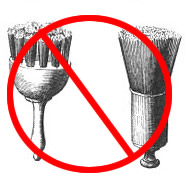
Original Illustration Taken from
Encyclopedie
des
Sciences et
Metiers
Vol. 7,
p. 116,
by
Denis
Diderot (1769)
brushes appear to have been made in France sometime in the 18th century, although the details supporting this seem to be rather sketchy. Rory McCredie says they they were invented at the start of the 18th century1, The Art of Shaving website places their origin in the middle of the 18th century2 and Allan Peterkin, author of One Thousand Beards explains that the French "introduced the shaving brush in 1748"3. Wikipedia identifies it as being sometime in the mid 1750s.4 None of these cite a primary source for their dates, so it is still not clear when the shaving brush was first utilized.
McCredie, who suggests the earliest date for the origin of the brush, does explain that whenever they were invented, shaving brushes "came to England in 1750-60, but shaving brushes were not widely used until the 19th century. The soap was rubbed in with the hand or a sponge."5 This may explain why sponges were included in Woodall's list of barbering necessities.6
As a point of interest, when brushes did start to become a part of the surgeon's equipment after the golden age of piracy, they were used to froth the soap and apply it to the customer's face.
1 Rory W. McCreadie, The Barber Surgeon's Mate of the 16th and 17th Century, p. 41; 2 History and Tradition, theartofshaving.com, gathered 11/12/13; 3 Allan Peterkin, One Thousand Beards, p. 65; 4 Shave brush, wikipedia.com, gathered 11/14/13; 5 McCreadie, ibid; 6 John Woodall, the surgions mate, 1639 Edition, not paginated

